An Introduction to OU Metagame Trends and the Influence of Sand on the Tier
| « Previous Article | Home | Next Article » |
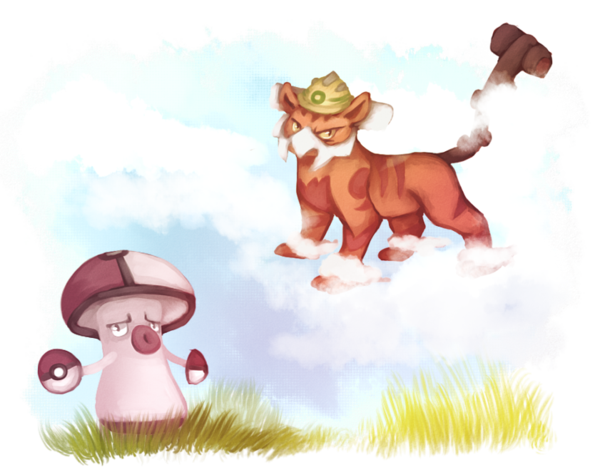
 Introduction to Metagame Trends
Introduction to Metagame Trends 
What is a metagame trend? There are many ways to attempt to define "metagame," but the purpose of this article does not require a very technical definition. A metagame, in a loose sense, refers to the current state of affairs in some game: what strategies are prevalent? Because Pokémon is a multifaceted game, elaborating on these strategies takes multiple forms such as describing common team archetypes, powerful cores, exploitable weaknesses of common builds, and so on. A trend within the metagame is a set of changing occurrences that follows a pattern. We are interested in large trends that are easily observable that can be discussed with some level of certainty. Let's explore two instances of popular moves on Pokémon in the OU tier, and whether or not they would be considered metagame trends.
Latios
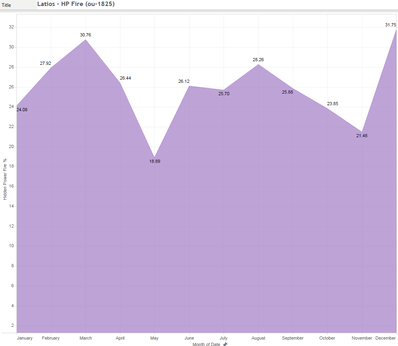
 Latios @ Life Orb
Latios @ Life Orb- Ability: Levitate
- EVs: 4 Def / 252 SpA / 252 Spe
- Timid Nature
- - Draco Meteor
- - Psyshock
- - Hidden Power Fire
- - Recover / Defog
Hidden Power Fire is certainly a solid coverage move on Latios, but its usage would not be considered a trend for our purposes. We want to discuss obvious trends, but the fluctuations in the number of Latios running Hidden Power Fire over time does not reveal any such trend. It is possible that there are smaller or more subtle trends at work here, but it is difficult to prove or disprove this. Instead, we should focus on trends that we are sure about and do not need strong data analysis methods to prove.
Clefable
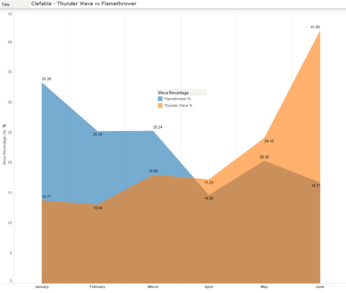
 Clefable @ Leftovers
Clefable @ Leftovers- Ability: Magic Guard
- EVs: 252 HP /172 Def / 84 SpD
- Calm Nature
- - Calm Mind
- - Moonblast
- - Soft-Boiled
- - Flamethrower -> Thunder Wave
The use of Thunder Wave on Calm Mind Magic Guard Clefable is an unmistakable trend. In January 2015, Flamethrower was the more popular move because it allowed Clefable to threaten many of its Steel-type checks. However, by April, Thunder Wave was seeing more usage than Flamethrower in OU-1825 ladder stats.
The reason for this is simple when we consider what the usage of Flamethrower on Clefable meant. Players were reacting and understanding that Pokémon like Mega Scizor and Ferrothorn were not answers to Clefable anymore and instead used Pokémon like Heatran as their Clefable answer. This trend in reaction to the use of Flamethrower on Clefable led to few opportunities to sweep with your Clefable as long as the opponent had a Heatran, which meant Clefable was saved primarily for late-game. Gengar and Mega Metagross are other examples of Pokémon that could take a Flamethrower and scare out Clefable, which meant Clefable could be stopped short of a sweep fairly easily in early- and mid-game situations.
Thunder Wave rose in popularity because it made all of these potential hard checks (or counters, in Heatran's case) that arose as answers to Flamethrower sets into liabilities. Nobody wanted to switch in Metagross, Gengar, or Heatran for fear of being paralyzed. People realized that this aspect of team support allowed Clefable to be more threatening in early- and mid-game stages, when Clefable could use Calm Mind to feign a sweep and lure in a threat and then proceed to cripple said threat with Thunder Wave. This change made Clefable a much more threatening wincon because it could both support itself and the rest of the team by crippling foes. This example actually encapsulates multiple trends: a reaction by the metagame to Clefable that run Flamethrower and then a subsequent reaction that took advantage of this initial reaction.
We have elaborated on some of the basic properties of a metagame, the attributes of trends that we are interested in, and examples to illustrate finer details of that discussion. Now we can progress to our discussion on metagame trends that have occurred in the OU tier in the waning months of 2015.
 The Influence of Sand on the Tier
The Influence of Sand on the Tier 
Hoopa-U's release, in addition to the plethora of already menacing wallbreakers roaming the OU tier, has been detrimental to the viability of bulky balance and stall archetypes. This effect was compounded when Shadow Tag got banned, as the strongest stall archetypes were using Gothitelle to remove breakers that were problematic to deal with. These factors have caused offensive archetypes to rise in viability and many balance archetypes to become more offensively oriented.
These major metagame changes paved the way for sand to become an even more potent playstyle than it was before. Sand Rush Excadrill preys on a plethora of offensive Pokémon with its unrivaled Speed under sand along with a potent STAB combination. Tyranitar has long been one of the best support Pokémon in the tier as the premier Pursuit user, which gives it excellent synergy with Keldeo as well as threatening common hazard removers. In addition, with balance teams choosing to employ more offensive presence, Hippowdon + Excadrill is a very viable option.
Trends that create large changes in the metagame will give rise to newer trends that benefit from the original changes. The increased usage of sand has had several impacts on the metagame and influenced several other trends that have come about. Next, we are going to elaborate on a few of these trends.
Trend #1—Rocky Helmet on Landorus-T
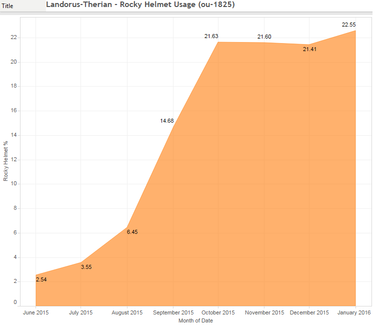
 Landorus-T @ Rocky Helmet
Landorus-T @ Rocky Helmet- Ability: Intimidate
- EVs: 252 HP / 240 Def / 8 SpD / 8 Spe
- Impish Nature
- - Earthquake
- - U-turn
- - Stone Edge
- - Stealth Rock
Landorus-T has long been one of the premier threats in the OU metagame because of its excellent typing, stat distribution, and varied movepool. However, at one point, Rocky Helmet Garchomp became the more popular Ground-type Stealth Rock setter on offensive teams. It was capable of dealing more reliably with Talonflame, Mega Lopunny, Mega Metagross, and Bisharp than Landorus-T. Rocky Helmet + Rough Skin recoil damage often allowed Garchomp to set up Stealth Rock against these threats and other physical attackers as they whittled themselves down. It also made U-turn users pay a hefty price and helped many offensive teams alleviate a weakness to VoltTurn archetypes.
However, Landorus-T reclaimed the spot as the top Ground-type due to a couple of factors. One reason is that it is a much better answer to Mega Charizard X, which appreciated the rise of Garchomp and was able to take advantage of many teams that relied on it as their physical sponge. Another reason was Sand Rush Excadrill; although Garchomp does an excellent job of checking Excadrill from full HP, it does not appreciate switching into Earthquake, which is a non-contact move. On the other hand, Landorus-T discourages Excadrill from simply spamming Earthquake, and Intimidate also softens its blows for teammates.
But why Rocky Helmet on Landorus-T? Well, one reason is that it is simply derived from Garchomp's set. If Garchomp can be used to wear down threats with passive damage, it stands to reason that this could be great on Landorus-T as well. That said, one might think that this is simply a less effective version of Garchomp's set because less recoil damage is incurred. But as shown in the case of Excadrill, Garchomp can't actually force recoil damage from Rocky Helmet—because of Earthquake—whereas Landorus-T can. Rocky Helmet also allows it to achieve more chip damage on other Landorus-T that U-turn out, as they are less likely to use U-turn against a Garchomp. While it does not accrue as much recoil damage as Garchomp, any chip damage can still be instrumental in putting Pokémon like Excadrill or Mega Lopunny into KO range of another Pokémon.
A Leftovers Landorus-T can retain longevity and check Pokémon like Excadrill for a longer period of time than a Rocky Helmet variant. However, failing to accrue chip damage on Excadrill may leave it outside of KO range of a revenge killer like Belly Drum Azumarill. What this example illustrates is that the longevity of Leftovers can prove less useful than passive damage from Rocky Helmet. In many offense vs. offense matchups, wearing the opposing team down through passive damage like hazards and recoil can be critical in putting opposing Pokémon into KO range from revenge killers like Bisharp. These matchups are where Rocky Helmet Landorus-T really shines, and if you use one on your team, it will become clear why it is so effective in the current metagame.
Trend #2—Chople Berry on Tyranitar
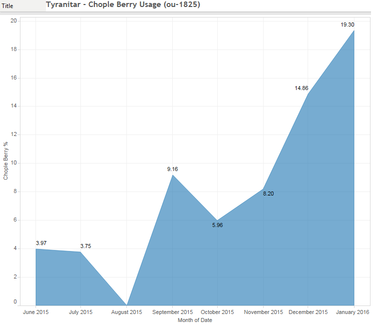
 Tyranitar @ Chople Berry
Tyranitar @ Chople Berry- Ability: Sand Stream
- EVs: 248 HP / 80 Def / 180 SpD
- Relaxed Nature
- - Stealth Rock
- - Stone Edge
- - Pursuit
- - Ice Beam
When discussing this trend, we will look at this through the lens of Tyranitar's support for a sand team. In contrast to Landorus-T, which fits onto a plethora of different offensive teams, Tyranitar that hold a Chople Berry will tend to primarily be found on sand offense team archetypes featuring Excadrill.
Tyranitar's brand of support in Pursuit trapping and using coverage moves as lures is more suitable for offensive teams than Hippowdon's defensive characteristics. Unfortunately, similarly to Hippowdon, Tyranitar shares several weaknesses with Excadrill, which forces sand archetypes to compensate for these weaknesses and in turn leads to some linearity in the builds. Usually multiple Water- and Fighting-resistant teammates are necessary so that Pokémon like Keldeo and Azumarill don't simply overwhelm the team with offensive pressure. As a result of multiple teambuilding constraints, some powerful balance breakers such as Mega Charizard Y, Tornadus-T, and Mega Alakazam can be very difficult for sand offense to deal with.
Mega Charizard Y is problematic for sand teams not only because it is difficult to switch into, but also because it can dictate the weather, which can limit Excadrill's opportunities to sweep. Granted, a Choice Scarf Tyranitar can check it, but then Stealth Rock support needs to be delegated to another team member. Unlike Mega Charizard Y, Tornadus-T and Mega Alakazam (even in base forme) both outspeed Choice Scarf Tyranitar and can OHKO it with super effective Fighting-type coverage. Furthermore, Tornadus-T is capable of pivoting with U-turn, which messes with a sand team's momentum and weather utilization turns. Mega Alakazam is even more threatening—and most likely the number one reason for this trend—as it is able to copy Excadrill's Sand Rush with Trace, compromising the primary method for speed control on sand teams.
Enter Chople Berry Tyranitar, a powerful source of counterplay to these threats and many others. In a one-on-one scenario with Tyranitar versus Mega Alakazam (or Tornadus-T), a Tyranitar equipped with a Chople Berry has a very large advantage, whereas other Tyranitar sets are at the mercy of Focus Blast.
The combination of all these threats to sand teams—among others such as Weavile—that tend to carry Fighting-type coverage has lead to the increasing usage of Chople Berry on Tyranitar. One might consider that Alakazam and Tornadus-T usages each trended to peaks long ago, while Mega Charizard Y usage hasn't risen, so why are more Tyranitar running Chople Berry? Well, the best answer to this is that it is probably a combination of increased popularity of several Pokémon (even if they are not all peaking in usage) as well as the release of Hoopa-U. Although Hoopa-U is banned now, it still played a part in shaping this trend. Chople Berry has seen use on Tyranitar in the tournament scene for a decent amount of time, but sometimes these things become popular later on when they increase in effectiveness. Ultimately, even if we cannot perfectly explain the timing of this trend, it has undoubtedly helped shape the future of the OU metagame.
Trend #3—Breloom usage increasing
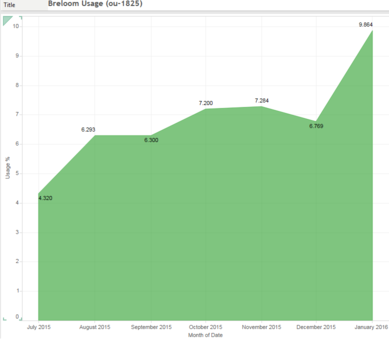
 Breloom @ Life Orb
Breloom @ Life Orb- Ability: Technician
- EVs: 252 Atk / 4 Def / 252 Spe
- Adamant Nature
- - Spore
- - Bullet Seed
- - Mach Punch
- - Swords Dance / Focus Punch / Rock Tomb
In contrast to the timing of the trend of Chople Berry Tyranitar being somewhat mysterious, the rise of Breloom usage's timing is easily explained. Breloom has increased in usage because of the downfall of Mega Venusaur as well as Celebi and its ability to check sand offense with Mach Punch.
Mega Venusaur balance was at one point considered one of the most consistent and dominant playstyles in XY, and its popularity continued far into ORAS. However, this past Fall, Mega Venusaur builds started to decline in popularity because of several factors. One of the primary influences was these teams' inability to handle stall, particularly Mega Sableye builds. A side effect of this was fewer stall builds using Mega Venusaur because Sableye's ability to control the hazard game and to pseudo-stallbreak proved more valuable. Furthermore, offensive teams adapted to the Mega Venusaur / Skarmory / Tyranitar builds that were powerful for so long. Balance playstyles in general became stretched very thin trying to handle both offense and stall. This forced balance teams to forgo the very linear Mega Venusaur for more versatile Megas, such as Mega Scizor and Mega Latias.
Celebi incidentally also suffered a severe loss in viability around the same time. Too much usage of Tornadus-T and Weavile in addition to the release of Hoopa-U just made it a liability. This decline in the most common bulky Grass-types was extremely beneficial for Breloom, as it could use Spore against more teams and found itself walled less often.
The prevalence of sand is also beneficial to Breloom, primarily because its STAB moves threaten sand cores. However, Spore and its fourth moveslot make it quite difficult to switch into and are the backbreakers for sand teams. In late 2015, many sand teams would run Pokémon like Latios or Tornadus-T as their primary check to Breloom. A few would run Grass-type Pokémon, but this was most commonly Ferrothorn, which does not appreciate Breloom's Fighting-type STAB moves. When considering the common Breloom switch-ins of these sand builds, it is plain to see that they are not truly reliable in the face of Spore and Breloom's coverage moves. Latios and Tornadus-T are not really great switch-ins for Breloom because of Spore, and they also lose to Life Orb variants with Rock Tomb or Focus Punch. Charizard isn't taking any of these moves well either, and even tanks found on sand archetypes like Landorus-T just don't appreciate being put to sleep.
The decline in Mega Venusaur and rise of sand teams and their lack of counterplay to Breloom caused it became a very viable option to threaten a variety of common team archetypes, which lead to a rise in its usage. However, the metagame adapted very quickly to Breloom with an increase in bulky Grass-types, so Breloom's fun in the sun did not last too long. This next trend is an example of a metagame trend that counteracted the rise of Breloom.
Trend #4—Amoonguss usage increasing
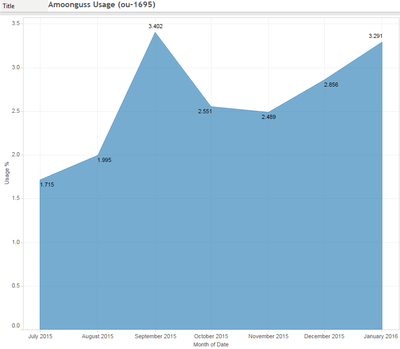
 Amoonguss @ Black Sludge
Amoonguss @ Black Sludge- Ability: Regenerator
- EVs: 248 HP / 168 Def / 92 SpD
- Bold Nature
- - Spore
- - Giga Drain
- - Clear Smog
- - Hidden Power Fire
Amoonguss's usage is heavily influenced by the drop in Mega Venusaur usage, as they often competed for a team slot as bulky Grass-types. This rise in usage is a phenomenon that can also be partially classified as reaction to the previous trend we discussed in Breloom's rise in usage. While Breloom can be very problematic for some teams, it is hard stopped by many Grass-types that both wall it and cannot be put to sleep with Spore. Amoonguss fits the bill, doesn't need to waste turns recovering like Celebi, and actually resists Fighting unlike Tangrowth.
Similar to Mega Venusaur, Amoonguss takes on a large number of very big threats in OU. However, due to Regenerator, its recovery is not hampered by weather and it won't be PP stalled or lose momentum on healing turns. It is a fairly solid switch-in to Keldeo, but it does not need to use a turn to recover like Latios and furthermore is not vulnerable to Pursuit trapping, which is very popular in tandem with Keldeo. It can also check another huge threat to sand offense in Azumarill. Azumarill has very few solid switch-ins, and this matter is only aggravated because Excadrill can be OHKOed by Choice Band Aqua Jet and Sand Stream users cannot tank its STAB moves. Mega Diancie is another Pokémon that Amoonguss does a great job of checking. Lately, Diancie has become very popular because it has excellent offensive synergy with many offensive threats and it is difficult to switch into. The ability Magic Bounce exerts pressure on the opponent even when Diancie is not in play because there is always the potential of making a very aggressive play. Further, Mega Diancie can use Protect to stall sand turns in order to limit Excadrill and does not fear switching into most support Tyranitar to block Stealth Rock.
Although it is no longer very strong in OU, Mega Altaria was once one of the strongest sweepers in the tier. It was considered very difficult to stop due to its great typing, which allowed it to set up on so much of the tier. Magnezone was a very strong partner that could remove the various Steel-types that walled Mega Altaria. Amoonguss has the benefit of beating Dragon Dance Mega Altaria without being Magnezone bait thanks to its defensive typing and the move Clear Smog.
But let's not forget Amoonguss's fantastic synergy with Tyranitar; it is another big reason Amoonguss has found a home on sand and other archetypes. They cover each other's weaknesses really well, with Amoonguss checking Fairy-, Water-, Grass-, and Fighting-types while Tyranitar checks Flying-, Psychic-, and Fire-types. Further, Sand Stream does not hinder Amoonguss's recovery as it does for Mega Venusaur. Amoonguss particularly appreciates Chople Berry Tyranitar, which better checks big threats to Amoonguss such as Mega Alakazam and Tornadus-T. Furthermore, Regenerator is just so good for sand teams that rely heavily on momentum because it will allow Amoonguss to utilize every turn to the fullest by not having to recover to stay healthy.
Amoonguss has certainly become more viable because it is an excellent pivot. Pivots have become increasingly useful in today's metagame, as they provide powerful counterplay to many threats and help keep momentum, which is important for every team. Although these other factors have helped Amoonguss expand its niche in the OU metagame, a large part of this change can be attributed to its synergy with sand teams and Tyranitar in particular. Being able to take on Pokémon such as Keldeo, Mega Diancie, Azumarill, Mega Lopunny, and Breloom is a blessing for sand teams, and Amoonguss does that job very well.
 Conclusion
Conclusion 
As you can see, the increased viability of sand teams has influenced many changes in the metagame. For example, Rocky Helmet became more popular on Landorus-T in large part due to Sand Rush Excadrill. The increased viability in sand teams along with a decrease in usage of Mega Venusaur also lead to an increase in usage of Breloom. In turn, Breloom's surge in usage helped boost Amoonguss's viability. We can link this to another trend—Chople Berry Tyranitar—which is a better Amoonguss partner than most other variants because of its ability to better take on Mega Alakazam and Tornadus-T more reliably. It is also important to notice which trends last and which don't; Breloom's popularity has waned because the metagame has adapted to it—although it did leave its mark—while Rocky Helmet Landorus-T and Amoonguss continue to be popular. Incidentally, Clear Smog Amoonguss is a very solid check to Thunder Wave Clefable, a trend we discussed earlier in the article. Although Amoonguss can get fully paralyzed, Clefable's Moonblast cannot do much damage to it, and a boosted Flamethrower is much more threatening. This illustrates how far trends can reach and that they can leave their mark on many other aspects of the metagame.
It is interesting to see the many forms these trends take—usage of a core, a Pokémon, a new set, a coverage move, or an item—and see how these trends interact with each other as well. The OU metagame is quite complex, meaning it is not possible to zero in on all causal relationships, and so there are undoubtedly going to be missing pieces in any explanation. Still, it is a good exercise to familiarize yourself with metagame trends because this knowledge provides powerful insight that can help in understanding the current state of the metagame, which helps immensely both in the Teambuilder and in battles.
| « Previous Article | Home | Next Article » |